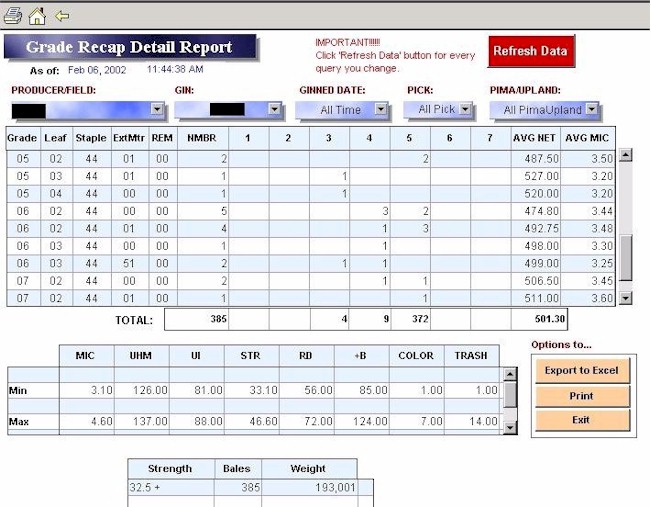

Anderson Clayton Corp. Delivers Real-Time Business Intelligence to U.S. Cotton Growers
by Eric Vollmer
MIS Director, Anderson Clayton Corp.
Anderson Clayton Corporation (ACC) is a diversified agricultural company offering cotton farmers all services related to the processing of cotton, including ginning, financial services, warehousing, brokerage, planting seed and wholesale seed supply. The company, owned by Queensland Cotton of Brisbane, Australia, knew it needed to resolve a common problem in the ginning industry: getting vital information into the hands of its customers in a timely manner.
The solution ACC has now, in the form of a SQL Server data warehouse and arcplan's business intelligence platform dynaSight, has come as the company phases out its legacy COBOL systems. The 98-year old cotton services company now has the capability to quickly produce relational and OLAP reports with filtering and drill down. Internal and external reports that once took hours to complete are now done in minutes.
Prior to using dynaSight, growers would have to request reports on an individual basis by either calling or stopping by their gin. Often by the time they received this information it would be out of date as information changes through out the day as cotton is ginned and financial transactions take place. Today a grower can be working in the field and notice environmental factors such as pests or soil conditions that may impact the price of the cotton. They can go back to their field office - or in many cases, even check their laptop in the field if they have wireless access - and make adjustments to their operations right on the spot. That's the truest expression of 'real-time' decision support. ACC's growers have been uniformly supportive about the implementation of dynaSight - it's very intuitive and user-friendly.
Anderson Clayton is using arcplan's dynaSight as a reporting interface to company and industry data stored in several Microsoft SQL servers and data warehouses. With SQL Server, ACC collects data into one common areas from three different subsystems. ACC can now track bales from ginning to warehousing and marketing with one reporting system. Current projects underway include converting Crop Finance and Grower Ledger. A mouse click provides real-time access to all relevant data, making complex end-user tools or training obsolete. Powerful internal functionality and flexibility empower developers to easily create unlimited analytical reporting applications without additional programming. dynaSight enables the seamless integration and presentation of multiple data sources on the front end, ensuring standardization and integrity of information.
Internally, ACC's managers use dynaSight to access and benchmark key performance indicators for the company such as ginning data needed to track production of their 18 gins. While the conversion to dynaSight has created dramatic internal productivity increases, ACC is most enthusiastic about the platform's benefit to its growers.
Today, growers not only can get reports more quickly, but they can also access four pre-defined reports on ACC's web site: Grade Recap, Grower Ledger, Ginned/Unginned Loads, and Bale Book. Application developers have found it easy to create reports requested by management and growers. The information contained in these reports can have a critical effect on grower's operations and pricing strategies. Before incorporating SQL Server and dynaSight, the old company web site was static, offering only low-level information such as a daily market report.

Grade Recap Report Screen Shot
More than 60 growers (representing more than 130 entities or farms with over 400 entities ginning with ACC) that currently represent 30% of their growers, tap into ACC's web repository for real-time market information, such as Grade Recap, Grower Ledger, Ginned/Unginned Loads, and Bale Book. Growers really like the service. The reports are provided at no extra charge and the growers can get the reports whenever they want.
The benefits to ACC have also been internally realized. Prior to introducing SQL server and dynaSight, it was a cumbersome and complex process for its MIS department to create specialized reports - whether for the growers or for internal users. Now ACC not only has many preconfigured reports at the ready, but should a user request a special report, it's effortless for staff to create an application in insight and it helped ACC to become more responsive to internal and external customer needs.
ACC sees this service as a way to improve communications with the growers and thus, retain growers. Once you lose a grower it can take three to five years to win them back. This information delivery service enables ACC to be a more effective - and innovative -- strategic partner. Growers can now print reports or export data to be used in their own computer systems. The response from growers has been tremendous and ACC is adding growers weekly.
Looking toward the future ACC will have ongoing meetings with growers in both states to continue bettering services. The goal is to provide our growers and cotton mills the data and service they need in real time.
Questions for Analysis and Discussion
For more information about Anderson Clayton Corp., visit its Web site at www.andersonclayton.com/. In September, 1997, Anderson Clayton Corp. was acquired by Queensland Cotton Holdings Limited, an Australian ginner and marketer of cotton.
For more information about arcplan, Inc. visit www.arcplan.com.
For more information about Microsoft products and services, call the Microsoft Sales Information Center at (800) 426-9400 or visit www.microsoft.com.
Holly Winzler at Altus Group for arcplan, Inc. provided permission to use this case study at DSSResources.COM on Thursday, May 23, 2002. Posted at DSSResources.COM July 12, 2002. The final Grade Recap Report Screen Shot was received and posted July 15, 2002.
Please cite as:
Vollmer, E., "Anderson Clayton Corp. Delivers Real-Time Business Intelligence to U.S. Cotton Growers", Anderson Clayton Corp., May 2002, DSSResources.COM.
Used at DSSResources.COM by permission. Product names and trademarks may be trademarks and/or registered trademarks of theirrespective companies.
This case study is for informational purposes only. DSSResources.COM makes no warranties, express or implied, in this summary.